Note: This article contains affiliate links. If you click through and make a purchase, we earn a small commission at no extra cost to you.
We have a Wedgetail Camper with a REDARC Manager30 and a 200Ah REDARC Lithium battery. We figured out a way to connect two solar panels to the camper at the same time.
- It’s All In The Wiring
- Ask The Experts!
- A Good Result
- Some Considerations
- In Summary
- FAQs – Common Questions About Connecting 2 Solar Panels
- Can you connect two solar panels to one battery?
- Can I connect two different solar panels together?
- What about connecting multiple solar panels to one battery?
- How do you match a solar panel to a battery?
- How many solar panels does it take to charge a 12 volt battery?
- How many batteries do I need for a 400 watt solar system?
- Can a solar panel overcharge a battery?
- What types of solar panels are available on the market?
It’s All In The Wiring
The Wedgetail Camper has two solar inputs via red Anderson plugs. The first is on the roof. This is used when the solar panel is stored for travelling.
When the Wedgie is open, the roof hinges over 180 degrees and becomes the base of our bed. It doubles as an awning over the outside kitchen. The solar panel can be removed and used as a portable panel with a 10 metre extension lead.
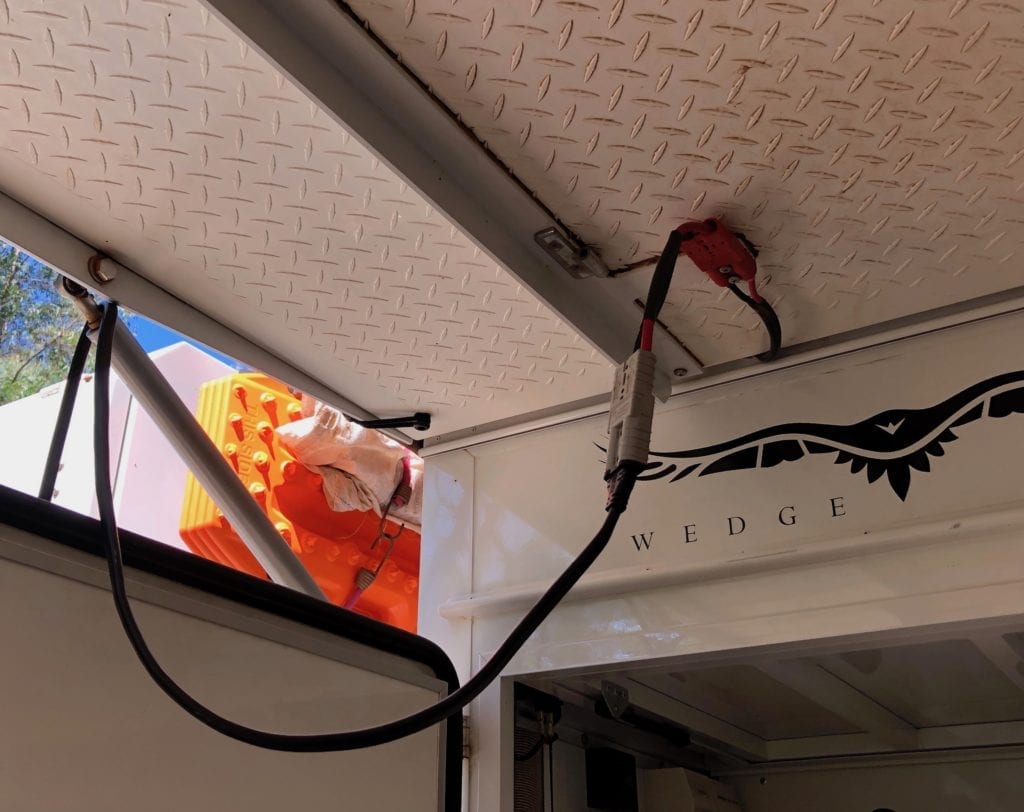
The panel is mono crystalline, 200W maximum output.
When used as a portable panel, there’s a second red Anderson plug on the front right corner of the Wedgie. This is where you plug in the extension lead when the panel’s being used as a portable unit.
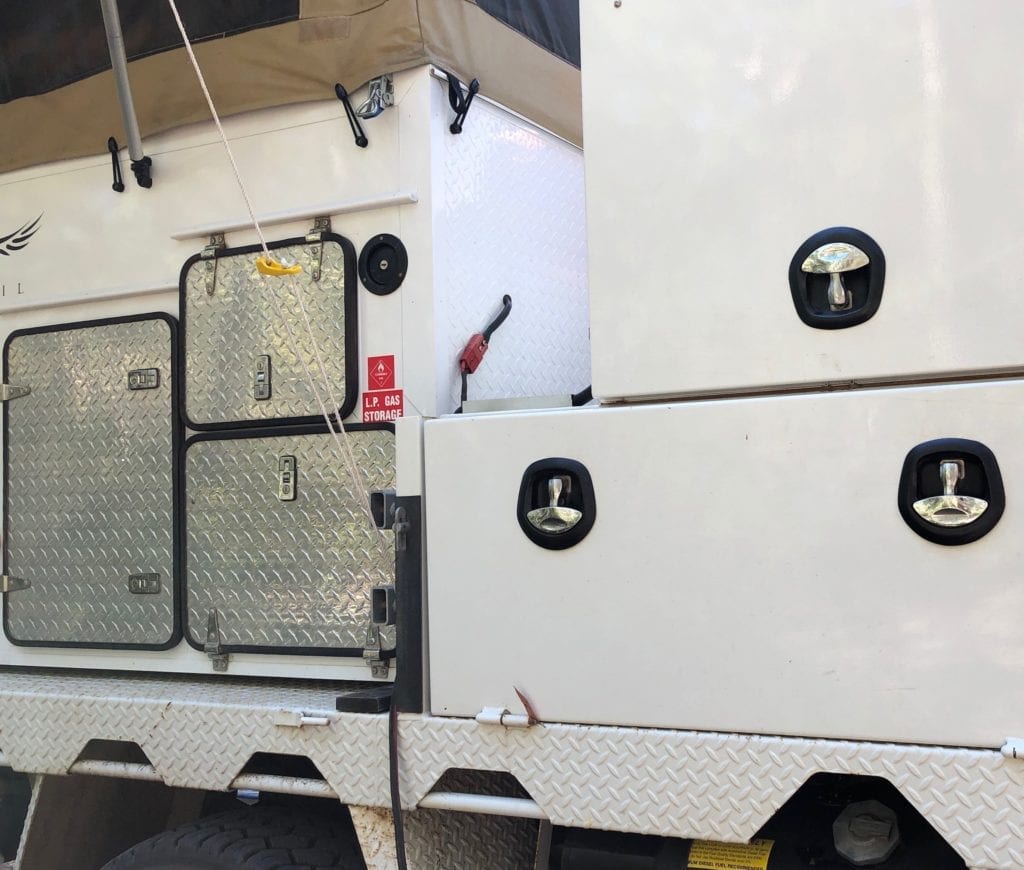
In this configuration the red Anderson plug on the roof (now on the underside of the outside kitchen awning) is not used. I’ve always wondered if it’s possible to use both red Anderson plugs at the same time… have one panel connected to each.
We also have a REDARC 115W SunPower mono crystalline solar blanket. It was supplied with a 10 metre extension lead. REDARC use standard grey Anderson plugs, so I had to make a short adapter lead with a red Anderson plug on one end and a grey one on the other.
Note: For a 12 month review of our REDARC solar blanket, go here.
Why did I need the adaptor plug?
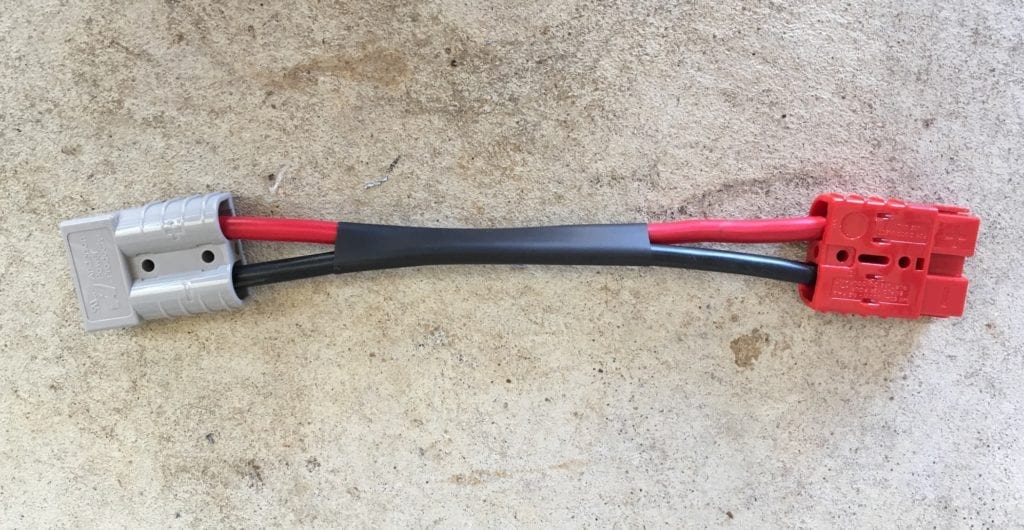
Well we often leave the solar panel on the roof and use the solar blanket instead. It’s just easier to get out and set up compared to wrestling with the large panel. And interestingly the 115W solar blanket’s output is consistently lineball with the 200W solar panel’s output. You simply can’t beat quality…
But sometimes it would be handy to use the blanket and the panel at the same time… especially on cloudy days.
Ask The Experts!
I spoke to the people at Wedgetail Campers about how the two solar inputs were wired. They assured me they’re individually wired to the REDARC Manager30 solar input, with no tricky devices in between.
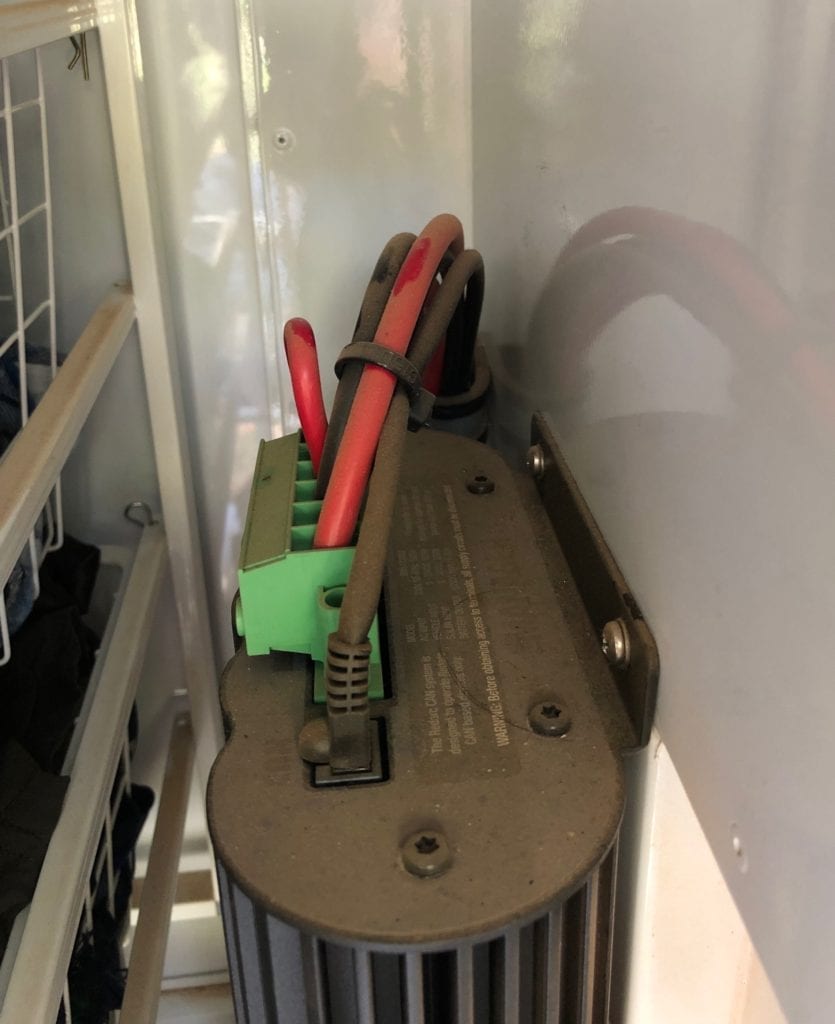
All good so far.
The next step was to contact REDARC. I gave them two important pieces of information:
- how the solar inputs to the BMS were wired, and
- what type and size both the solar panel and solar blanket were.
They confirmed there would be no issues running these simultaneously. Thanks to Jessica and the tech team at REDARC for your help.
A Good Result
So now we can use the portable panel and blanket together. With both panels connected we push about 12A into the system. This is about double compared to when just one panel is connected.
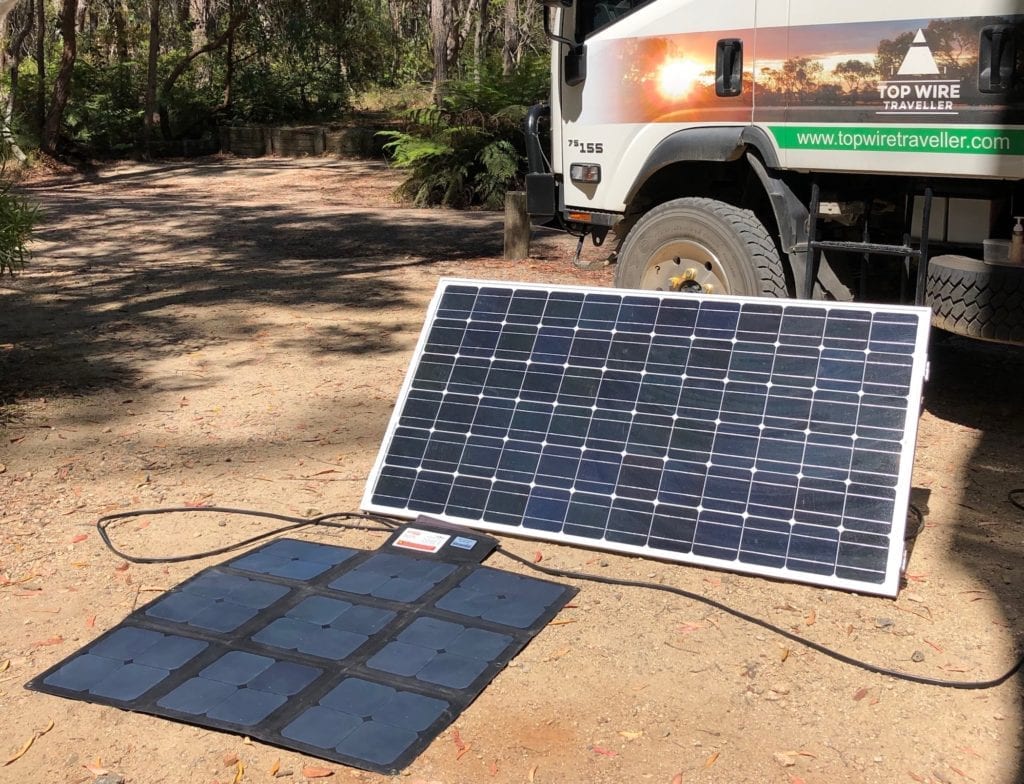
We did 2 tests to compare to outputs of the panel vs the blanket. Here’s a few figures for you:
Conditions:
- Solar blanket flat on the ground.
- Solar panel angled perpendicular to the sun.
- Sunny day, no clouds, January (perfect conditions!)
- The individual contributions of each panel/blanket were measured by disconnecting the blanket and checking the revised current.
Test 1:
- Input voltage = 14.2V
- BMS output to 2nd battery system = 11.5A total
- Power (14.2 x 11.5) = 163W
- BMS output, Panel connected = 6.4A (or 56% of total)
- BMS output, Blanket connected (11.5 – 6.4) = 5.1A (or 44% of total)
Test 2:
- Input voltage = 14.4V
- BMS output to 2nd battery system = 12.0A total
- Power (14.4 x 12.0) = 173W
- BMS output, Panel connected = 6.6A (or 55% of total)
- BMS output, Blanket connected (12.0 – 6.6) = 5.4A (or 45% of total)
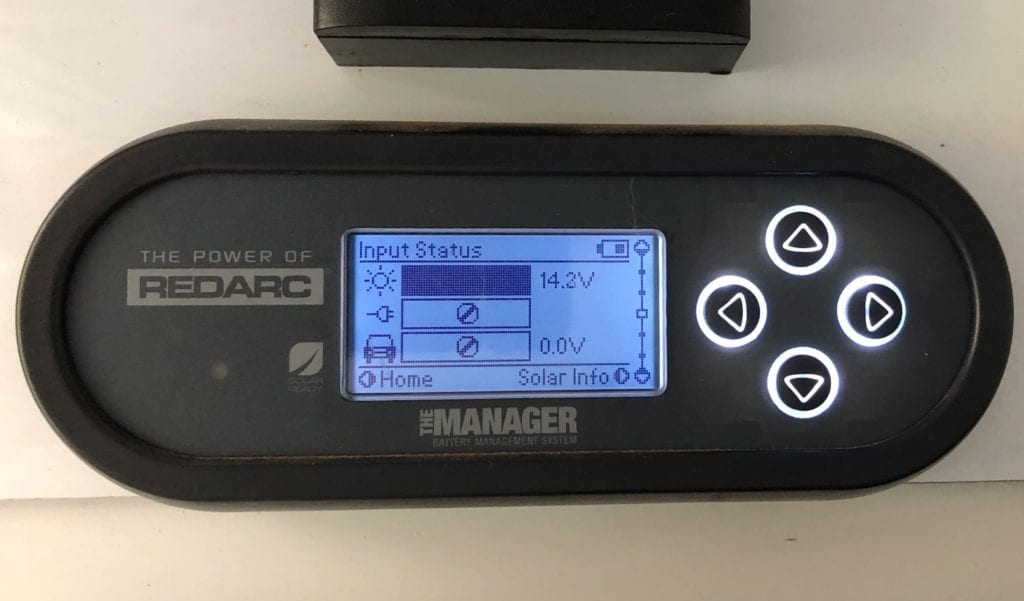
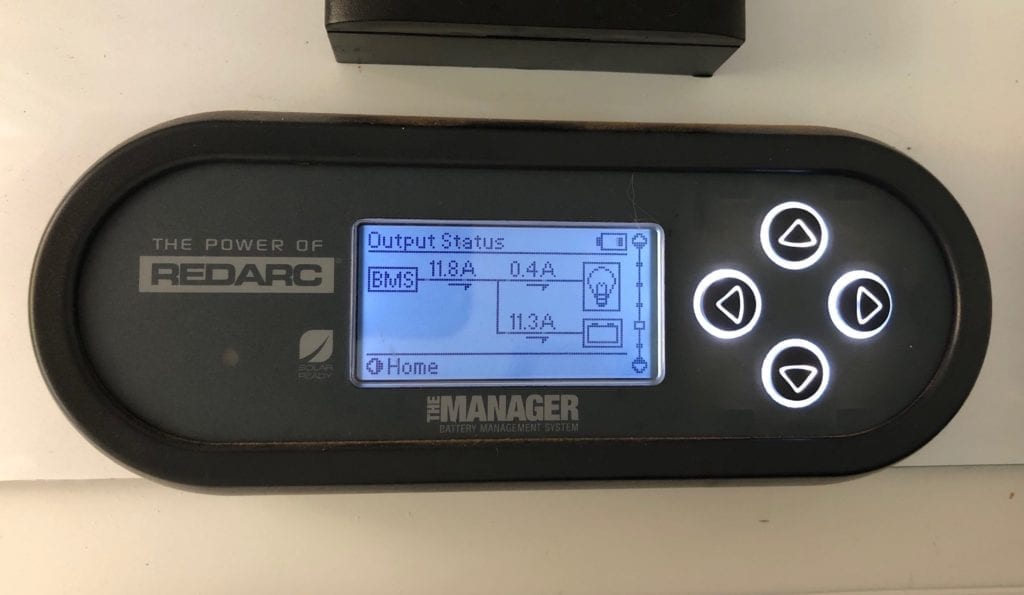
A couple of comments on these results:
- The solar blanket’s maximum output is supposedly only 58% of our solar panel (115W vs 200W).
- The solar panel was angled at the optimum angle to the sun, whereas the blanket was simply laid flat on the ground.
- Yet the REDARC solar blanket consistently contributed 45% of the total input power. You could say it’s punching above its weight!
Some Considerations
You too can connect two solar panels into one system, just like we do. REDARC sell a ready-made cordset with grey Anderson plugs. It allows you to connect two panels, then connect them into one solar input.
Just check a few things first:
Are the solar panels compatible?
The best way to find out is to contact your solar panel supplier. I contacted REDARC because the solar blanket was their product.
What is the maximum rated input power of your BMS?
The REDARC Manager30 has a maximum solar input rating of 520W. Our panels are rated at 115W and 200W for a total of 315W. So we’re well within allowable range.
Is the solar input cable heavy enough to handle the higher current?
If your BMS has been wired correctly, the solar input cable should be large enough to handle the maximum input current that the BMS is rated to. You can ask the manufacturer of your camper or caravan to confirm this. The last thing you want is to melt the cable and start a fire.
Alternatively, you can check it yourself. Use this handy calculator to check the required cable size.
Do either of the panels have a built-in regulator?
If so, you might not be able to connect them. Alternatively you might have to remove or bypass the regulator. Contact the supplier of your battery management system.
In Summary
We now have the ability to re-charge our second battery system quickly and efficiently. On clear sunny days, one panel is more than enough. But on those cloudy days, you need every bit of solar power you can find.
With some simple investigation, you might find you can do the same.
P.S. If you’re looking to buy, Outback Equipment have some good deals on Solar Blankets and Battery Management Systems.
Enerdrive have released a high quality, entry-level 100Ah Lithium battery at a competitive price. Go here for details.
FAQs – Common Questions About Connecting 2 Solar Panels
Can you connect two solar panels to one battery?
You might think we’ve already answered this. However, there’s one consideration…
To power a dual battery system, you’ll need to connect the panels in parallel.
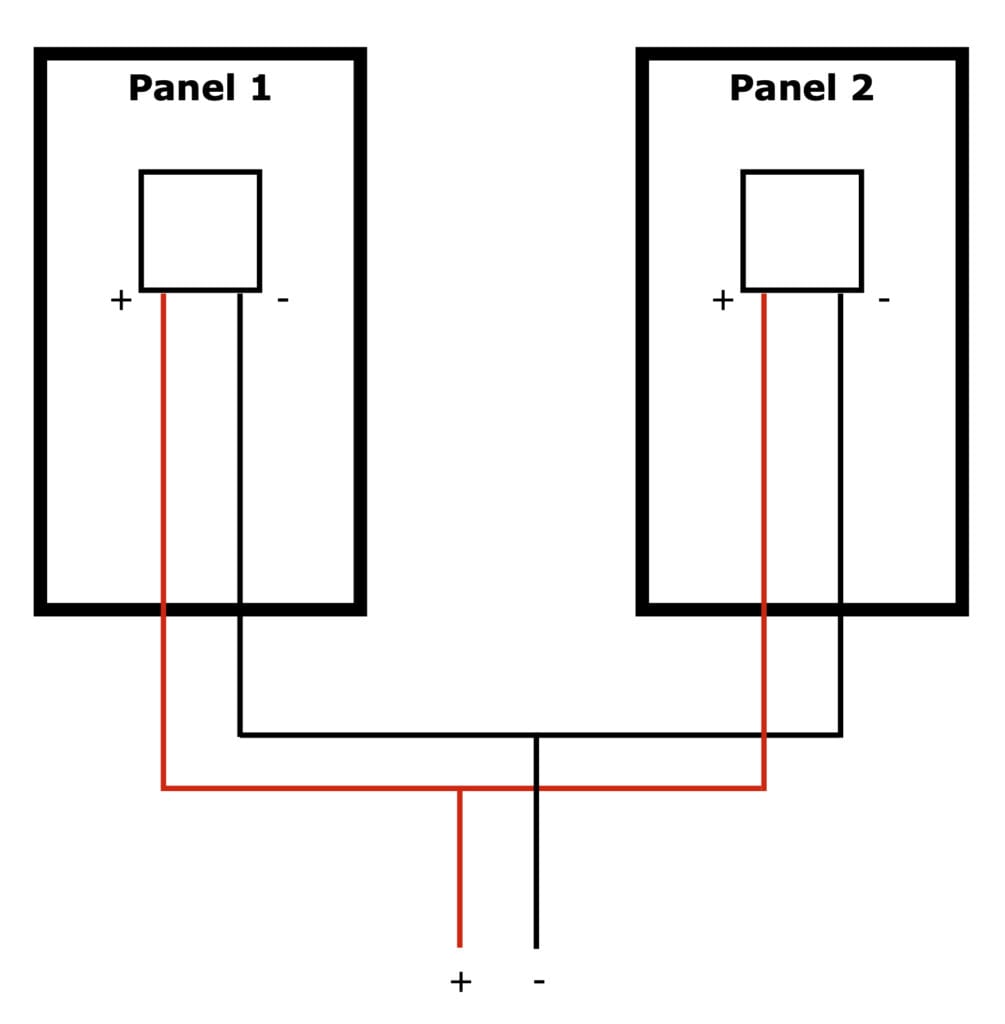
If both panels are rated at the same maximum voltage, then you’ll get maximum output. For example, our 115W SunPower solar blanket has the following ratings:
Maximum rated voltage = 19.8V
Maximum rated current = 5.8A
Maximum rated power = Volts x Current = 19.8 x 5.8 = 114.8W
If you connect two of these blankets in parallel, you’ll get:
Maximum rated power = 2 x 19.8 x 5.8 = 229.6W
However if you have two panels with different output ratings, the maximum voltage for the system is determined by the panel with the lowest maximum rated voltage.
Confused? Let’s look at what happens when we connect our solar panel and solar blanket.
Panel:
Maximum rated voltage = 18.0V
Maximum rated current = 11.1A
Blanket:
Maximum rated voltage = 19.8V
Maximum rated current = 5.8A
When you connect them in parallel, this is what you’ll get:
Maximum rated power = (18.0 x 11.1) + (18.0 x 5.8) = 304.2W
So the output from the solar blanket will be de-rated to (18.0 x 5.8 =) 104.4W or by 10%.
In our case, it’s not a big deal.
It’s more when you have a bank of panels connected in parallel, for example 6 on the roof of a motorhome. Then you start to lose significant capacity.
Can I connect two different solar panels together?
See “Can you connect two solar panels to one battery?” above.
What about connecting multiple solar panels to one battery?
You can connect them in parallel, providing your battery management system can handle the maximum input power.
How do you calculate maximum input power? See “Can you connect two solar panels to one battery?” above.
In our situation, maximum input power is 304W. Our REDARC Manager30 is rated to 520W max. solar input, so it’s okay.
In contrast, the REDARC Manager15 is rated to 260W max. solar input, so would be too small for our application. It would still operate okay, but you’d be wasting the extra capacity of the solar panel/blanket combination.
How do you match a solar panel to a battery?
Sorry, there’s no easy way to answer this! I hope you like maths…
- Figure out what devices you want to run. For example:
- A fridge draws 7A and runs for 20% of the day (24 hours). So average current draw in one hour is 7 x 0.2 = 1.4Ah
- An inverter draws 45A for 5% of the day. So average current draw in one hour is 45 x 0.05 = 2.25Ah
- USB ports and LED lights draw 5A for 20% of the day. So average current draw is 5 x 0.2 = 1.0Ah
- Water pump draws 7.5A for 5% of the day. So average current draw is 7.5 x 0.05 = 0.375Ah
- Add all these together:
- (1.4 + 2.25 + 1.0 + 0.375) = 5.0Ah.
- Let’s round it to 6Ah.
- What does this mean? Well, in 24 hours you’ll use 24 x 6 = 144Ah. Say 150Ah.
- Your solar panels must be capable of supplying this. Let’s size your solar panels:
- Assume a maximum of 6 sunlight hours.
- So in 6 hours they must provide 150Ah to the battery or 150/6 = 25A.
- At 25A and assuming the solar panels supply 12V, you’ll need a 25 x 12 = 300W of solar panel capacity.
- Allow at least 10% extra capacity:
- So you need 300 x 1.1 = 330W of solar panels.
- Your most likely match will be 350W.
- What size battery do you need?
- Deep cycle batteries don’t like to drop below 50% capacity (Lithium batteries can go much lower without damage).
- You use 150Ah in 24 hours. But you can’t discharge below 50%. So you need 300Ah.
- The solar panels supply 150Ah in 24 hours. They will recharge your battery to 100% every day (assuming 6 hours of usable sunlight).
In Summary:
You don’t just match the solar panel to the battery. You have to know the loads on the battery, size the battery to suit the load and then size the solar panels to suit both the load and the battery.
I told you the answer wasn’t simple!
How many solar panels does it take to charge a 12 volt battery?
See “How do you match a solar panel to a battery?” above.
How many batteries do I need for a 400 watt solar system?
See “How do you match a solar panel to a battery?” above.
Can a solar panel overcharge a battery?
Yes! Never connect a solar panel directly to a battery. It needs a regulator between the panel and the battery.
The regulator will either be mounted on the back of the solar panel or within a battery management system (BMS). The regulator regulates (funny that!) the voltage from the solar panel and protects the battery from over-voltage.
What types of solar panels are available on the market?
There are three main types. They are:
- Polycrystalline
- Monocrystalline, and
- Thin film.
SolarMagazine.com have a really useful and informative article on the differences between these 3 types of solar panels, plus a whole lot of other useful information.
Go here for more How-To Guides and tips.

Get your Traveller’s Guides
… and a whole lot more at our FREE RESOURCES Page!
Any questions or comments? Go to the Comments below or join us on Pinterest, Facebook or YouTube.
Any errors or omissions are mine alone.
NOTE: The REDARC solar blanket was supplied to us free, in return for a review. (That said, our reviews are always honest and authentic – we tell it how it is).


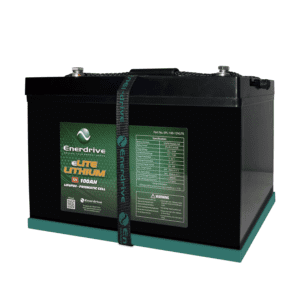
Thank you for a great article.
How would your connect two systems together? For example, if you have a fixed solar system on the RV roof with a charge controller and, for example, a portable 100 watt solar suitcase with its own controller connected to the battery; how does that work?
Hi Rodney,
It can be done, however you have to be careful.
In your example, assume the portable solar suitcase is connected to the battery as you stated. To connect the RV solar system, you would have to run a second set of cables from its charge controller directly to the terminals of the battery you want to charge. So the RV solar system now has two sets of cables, one to its own battery and another set to the battery you want to charge.
You would then need to install isolators/switches in those 2 sets of cables, so that the RV system’s charge controller is only ever connected to one of the batteries at any one time.
This way, the individual charge controllers will only see the voltage of the battery you’re trying to charge.
But… make sure the charge controllers don’t allow current to flow in reverse, ie from the battery back into the charge controller. The charge controller manufacturer should be able to confirm this. Also, don’t exceed the maximum charging current of the battery. For example, if it’s a lead-acid battery and you do exceed the maximum charging current, you can boil it dry.
Unfortunately, it’s not a simple yes/no answer. It depends on the charge controllers, the battery type and the maximum charging current of the battery.
Hope this helps. Cheers, Andrew
Great blog! I like your tips. Thanks for sharing your thoughts. I agree that the solar panel was angled at the optimum angle to the sun.
Thanks Mark. Cheers, Andrew
Very informative and learning from you. Thank you Sir! Stay blessed!
Thanks Stanley! Cheers, Andrew
Can you re-assure me?
I have a 150w solar panel fixed onto my ute canopy running through a redarc regulator charging a deep cell battery which runs the Engel. I also have a VSR which charges this battery whilst driving. All fused correctly. The solar panel is connected to this battery via Anderson sockets.
I also have a free standing three panel foldaway redarc assembly which I use to to charge the caravan battery again through it’s own redarc regulator (this separate from the ute’s system)
My question is: Can I unplug the ute’s roof panel at the Anderson Plug and then plug in the redarc foldable three panel. Hope you can help me – Thank you.
Hi David,
Assuming the regulators are before the Anderson plug (which it sounds like they are), then yes you can unplug the ute’s roof panel and then plug in the REDARC folding panel. As long as you have a solar regulator between the panel/s and the battery, then you’ll be fine.
Hope this makes sense. Cheers, Andrew
G. Day first time I have seen your site. Question with multiple remote panels with regulatory can I connect directly to the battery bank (300 amp) many thanks in advance.
Hi Geoff,
If you have a regulator, then yes you can connect directly to the battery bank. Cheers, Andrew
I have two solar panels mounted on my pop top ( no idea what wattage) which has a 5amp conergy regulator in the front boot. I also have a foldable 200w solar panel with mppt regulator. Can I connect the remote panels directly to the battery
Hi Nigel,
If the solar panels have a regulator (which you say they do), then you can connect them directly to the battery.
Cheers, Andrew
Thank you Andrew
Any time! Cheers, Andrew
A very good article , but i’m still confused .
Thanks David. Yes, it’s all very confusing! Is there anything specific you’re not sure about? Cheers, Andrew
I like this programme
I have different solar panels 1 with 40 watts , 2 with 50 wtts and 3 with 30 wtts. And a battery power is 75Ah, so how can I connect them?
Hi Erick,
If any of the solar panels have regulators, you’ll need to remove them. Your total wattage is (40+2×50+3×30=) 230W. So you’ll need a regulator (or BMS or BCDC charger) which can handle at least 230W. Then connect the regulator/BMS/BCDC to the battery.
Connect the positive cables from all the solar panels to the positive input terminal on the regulator/BMS/BCDC, then do the same with the negative cables.
So you’ll have the solar panels wired into a regulator/BMS/BCDC, which is then wired to the battery.
Hope this helps,
Cheers, Andrew
Still trying to understand solar power.. just purchased my first solar system for off grid.. I have a 100 watt and 25 watt panel. Im confused why my battery voltage drops during the day. The only thing running is 46 inch tv. Do I not have enough panels to power the TV and keep batteries fully charged during day light?
Hi Bob,
It’s a bit difficult to answer without knowing how your system is set up. A 46″ TV will use somewhere between 60W and 200W, depending on what type of TV it is.
Here are a few things to consider.
Your panels should supply a maximum of 125W… in theory. In practice, the actual output depends things like:
It sounds like you need more or larger panels. Again though, it’s difficult to say without knowing how your system is set up and what else you run from the system.
Hope this help. Cheers, Andrew
Hi,
I have a 200w blanket and a 160w sandwich board both with their own mppt controllers that I piggy back together via a 2 into 1 Anderson plug, then off to battery.
Is this ok?
Would I be better off trying to run to battery completely separately?
Would it work better if I had one say 40amp mppt solar controller, bypassing their own built in controllers
Look forward to your response
Regards Sean
Hi Sean,
Yes, what you’re doing is fine.
MPPT controllers check the input coming from the solar panel, monitor the battery voltage, do some internal calculations, then maximise current flow into the battery. This ensures the battery is charged as quickly as possible. Each MPPT controller continually reacts to what battery voltage it reads, so they’re effectively self-regulating.
You won’t damage the battery and the MPPTs won’t interfere with each other.
Cheers, Andrew
Hi,
Similar to Sean above, I also have a 200w blanket with separate MPPT controller and an older 160w sandwich board too, but with a PWM regulator mounted to it (and not an MPPT controller). I am considering piggy backing both to either a deep cycle battery in boat or a new Lithium 120AH battery in vehicle together via a 2 into 1 Anderson plug, then straight to either battery.
Do the different regulators need to go straight to the battery independently or can I position the MPPT reg next to battery and run the 160AH with PWM through the MPPT as well?
Neither batteries are set up as a dual system yet.
Thank you
Regards,
Cameron
Hi Cameron,
I would run the two different regulators to the battery independently. Running the output of the PWM into the MPPT will likely cause issues, as the PWM won’t know what the state of charge of the battery is.
Another option. If the MPPT controller has the capacity, position it next to the battery as you suggested. Then bypass the PWM altogether and run both the 160W sandwich board solar output and the 200W solar blanket output directly into the MPPT.
Hope this helps.
Cheers, Andrew
Hello,
If have a campervan 2002 dodge Ram 3500, it’s the old style, not like the Transits or Promasters.
This van has a factory battery bank (two deep cycle batteries) and the isolator is on the firewall under th hood.
I’m installing a solar system and need to disconnect the factory set because I’m also installing a renogy d c to dc charger with Mppt. This will charge my lithium battery as I drive, but the isolator in the factory set up needs to be disconnect.
The disconnection should be okay, so that I can connect my dC to dc charger to the start battery?
Also, my factory set up has a fuse panel like what’s in a house, will this all automatically change over once I connect everything?
Tha nk,
Kel
Hi Kel,
Assuming the new lithium battery will replace the existing factory battery bank, do the following:
– Install the DC-DC charger as close to the lithium battery as practical.
– Run the existing power supply from under the hood to the input of the DC-DC charger. If the isolator’s a VSR (voltage sensing relay) or similar then, yes remove it. If it’s a simple manual on/off switch, leave it in there.
Regarding the fuse panel. It’s powered from the battery, so yes it’ll be fine.
Hope this helps. Cheers, Andrew